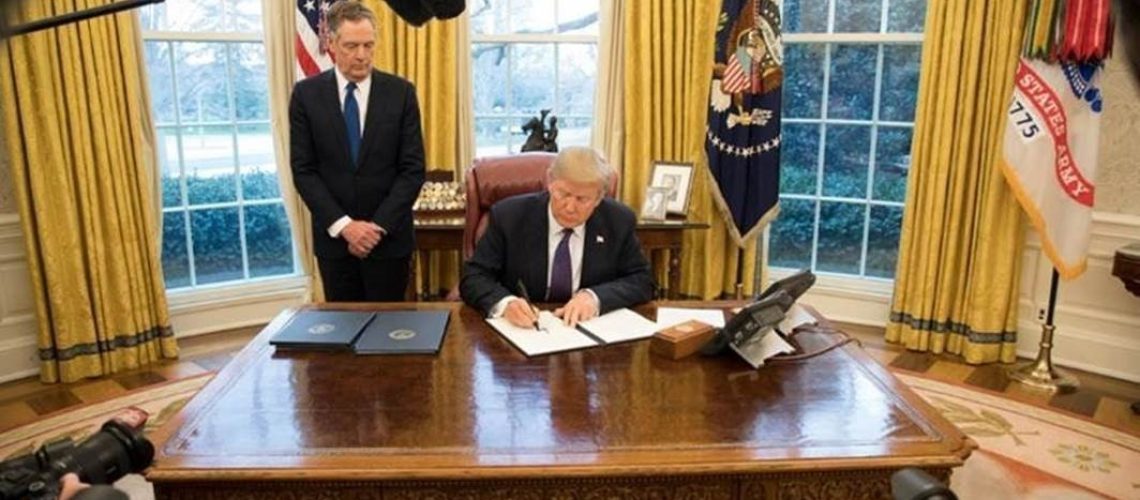Tariffs of 10% are applied to most products from most countries, but energy and energy products, steel, and aluminum are exempt, as tariffs have already been applied.
The Trump Administration passed tariffs starting on April 5 that will apply to most countries at a rate of 10%. The tariffs apply to a wide range of imports, covering most products.
The rates will be replaced by a higher “reciprocal” rate between 11% and 50% to 60 countries starting on April 9 and are designed to match tariffs and related trade enforcement from 60 countries.
The additional tariffs will not apply to “energy and energy products” as well as steel and aluminum, which were recently applied 25% tariffs in a separate order in February.
“Large and persistent annual U.S. goods trade deficits have led to the hollowing out of our manufacturing base; inhibited our ability to scale advanced domestic manufacturing capacity; undermined critical supply chains; and rendered our defense-industrial base dependent on foreign adversaries,” said the executive order.
The executive order signed by President Trump that adds 25% tariffs to imported steel and aluminum from most global providers will increase costs for all project types, from the small residential solar projects to the largest utility-scale solar plants.
SinoLink Securities said that aluminum frames were the most expensive solar panel manufacturing component in November 2024, representing 14% of total solar panel production costs.
In December, the Biden Administration doubled tariffs on solar products from China. Section 301 tariffs are 50% for polysilicon, wafers, and solar cells for products imported from China.
The U.S. solar module market saw a 4% increase in December, up by $0.01 per watt to $0.26 per watt. Modules using cells from Cambodia, Malaysia, Thailand and Vietnam — countries affected by the policy — saw a 7.7% price increase from November into December. While those prices have since eased slightly, they remain elevated, said a report from Anza.
The new round of April 5 tariffs do not apply to goods shipped from Canada and Mexico that are already assessed with 25% tariffs.
“The new tariffs will not apply to certain articles that Trump has already singled out for current or possible future sector-specific tariffs, such as steel, aluminum, some downstream products that use steel or aluminum, copper, pharmaceuticals, autos and auto parts, semiconductors, certain critical minerals and energy and energy products,” said Keith Martin, partner, Norton Rose Fulbright.
An Annex to the Trump order lists industry specific materials that will not be hit with the new round of tariffs. Polysilicon and other relevant materials are exempt from the increased tariffs. Find the full annexed list here.
Imports from countries that will be assessed higher tariffs on April 9 include:
| China | 34% |
| EU | 20% |
| Vietnam | 46% |
| India | 26% |
| South Korea | 25% |
| Indonesia | 32% |
| Malaysia | 24% |
| Cambodia | 49% |
| Israel | 17% |
| Japan | 24% |
| Taiwan | 32% |
The new tariffs are in addition to some existing tariffs, said Martin. “For example, Chinese goods will be subject to tariffs of 54% starting April 9: an existing 20% tariff that Trump imposed earlier plus a new reciprocal rate of 34%.”
AD/CVD tariffs
“If we want a thriving solar manufacturing sector—one that supports well-paying American jobs, delivers energy independence, and ensures resilient supply chains—we need strategic enforcement backed by a sustained commitment to investing in American manufacturing,” said Tim Brightbill, partner, Wiley Rein LLP, in an OpEd on pv magazine USA.
The solar industry is also reacting to tariffs created by a new round of antidumping and countervailing duty (AD/CVD) enforcement. In his OpEd, Brightbill said new U.S. government trade data revealed a dramatic decline in imports of solar cells and modules from the four Southeast Asian countries named in the (AD/CVD) petition. Imports by value have plummeted:
- Vietnam: down 91.5%
- Thailand: down 90%
- Malaysia: down 87%
- Cambodia: down 66%
“These aren’t minor fluctuations. These numbers make one thing very clear: The preliminary tariffs are working,” said Brightbill.
Stick – and carrot?
While tariffs are a “stick” that are expected to push U.S. manufacturing ahead, experts warn that the “carrot” is needed if they are expected to be successful in doing so.
“Regarding the solar industry, manufacturing is dominated by producers based in China who are willing to operate on thin margins. Without some protection to level the playing field against the prices they can offer, there is simply no game,” said Paula Mints, chief analyst, SPV Market Research, in an article published in pv magazine.
Mints said tariffs have historically been effective as tools to protect domestic industries, but not as “instruments of economic torture.” Mints said that incentives like those included in the Inflation Reduction Act are a critical element of a successful revival of manufacturing in the United States.
“It is doubtful that the United States could have realized the successful ramping of significant new capacity with tariffs alone,” said Mints.
A policy outcome that is highly anticipated by the renewable energy industry is the potential cuts to tax credits created by the Inflation Reduction Act (IRA) of 2022, which will be evaluated in the upcoming budget reconciliation process. According to the U.S. Treasury and Rhodium Group, manufacturing investment has boomed, including $114 billion for solar, $77 billion for battery manufacturing and $66 billion for energy storage.
(Read: “U.S. solar manufacturing boom ‘real — but fragile’“)
As for tariffs, the U.S. economy has broadly retracted in the trading session following the order. The Dow Jones Industrial Average plummeted roughly 3% in response to the change, and the U.S. dollar has fallen in relative value to the Euro about 2% to 3% in the direct aftermath.



